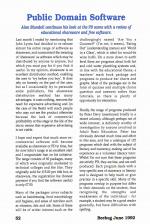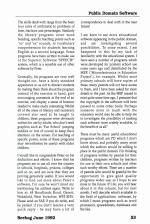
Beebug
 1st June 1992
1st June 1992
Author: Alan Blundell
Published in Beebug Volume 11 Number 2
Alan Blundell continues his look at the PD scene with a review of educational shareware and free software.
Public Domain Software
Last month I ended by mentioning that John Lyons had decided to re-release almost his entire range of software as shareware, and summarised the meaning of 'shareware' as software which may be distributed by anyone to anyone, but which you must pay for if you find it useful. In my opinion, shareware is an excellent distribution method, enabling the user to 'try before you buy'. It does rely on honesty on the part of the user, but as I occasionally try to persuade some publishers, the shareware distribution method has many advantages: it costs nothing, removes the need for expensive advertising and (in the case of the Beeb) will reach people who may not see the product otherwise because the lack of commercial profitability at this stage in the life of the micro means that expensive advertising is not viable.
I hope and expect that much more ex-commercial software will become available as shareware or PD in time, but for now John's range is an excellent start and I congratulate him on his initiative. The range consists of 60 packages, many of which were originally marketed to technical colleges and the like. They originally sold for £15.00 per title but, as shareware, the registration fee (honest payment if you find the software useful) is only £7.50.
Many of the packages cover subjects such as hairdressing, food microbiology and hygiene, and areas of nutrition such as vitamins, fats and oils. Some of these will be of wider interest such as the challengingly named 'Are You a Gourmet?' (I'm not, it seems), 'Eating Out' (understanding menus) and 'World in a Glass', which is ideal for would-be wine buffs. On a more down to earth level there are programs about both hot and cold water plumbing systems and, in line with the educational theme, a teachers' mark book package and programs to produce bar charts and graphs. Most of the packages are in the form of quizzes and multiple choice question and answers rather than tutorials, so there is plenty of opportunity for interaction.
Finally, the range of programs produced by Peter Davy (mentioned briefly in a recent column), although perhaps not of wide interest, is definitely worthy of investigation by anyone involved in Adult Basic Education. Peter has obviously devoted much time and effort to this area, and has a catalogue of 125 programs which deal with the subject of literacy and numeracy, making use of his experience as a volunteer literacy tutor.
Whilst I'm not sure that these programs are strictly PD, they are free, and are well produced. Each program deals with a very specific area of numeracy or literacy and is designed to help teach or give practice in a specific skill. Many of the programs overlap in purpose but differ in their demands on the student, thus recognising the strengths and weaknesses of the individual - for example, a student may be a good reader generally, but have difficulties with spelling.
The skills dealt with range from the basic four rules of arithmetic to problems of time, fractions and percentages. Similarly the literacy programs cover word building, specific teaching points such as '00' and 'ee' sounds, to vocabulary comprehension for students learning English as a second language. Some programs have been written to make use of the Superior Software 'SPEECH!' system, which is a sensible use of other software by Peter.
Generally, his programs are very well thought out, have a fairly standard appearance so as not to distract students by making them think about the program instead of the exercise in hand, give encouraging comments at the end of an exercise, and display a sense of humour needed to make study interesting. Whilst all of the areas of literacy and numeracy covered also need to be taught to children, these programs were obviously written for use by adults, who don't need graphics such as 'Fun School" jumping teddies or lots of sound to keep their attention on the screen. For teaching of specific points, some of these programs may nevertheless be useful with older children.
I would like to congratulate Peter on his dedication and efforts. I know that his programs are in use all over the country in schools, hospitals, prisons, colleges and so on, and am sure that they are proving genuinely useful. If you would like to find out more about Peter's software, I'm sure he won't mind my mentioning his address again. Write to him at: 68 Headlands Road, Ossett, Wakefield, West Yorkshire, WF5 8HX. Please send an SAE if you do write, and be patient if you don't receive a very quick reply - he may have a lot of correspondence to deal with in the near future!
I am keen to see more educational software appearing in the public domain, and am investigating several possibilities. To some extent, I am hampered in this by my lack of familiarity with the educational system. I have seen a number of programs which were developed for primary school use some years ago and distributed by the MEP. ('Microelectronics in Education Project'), for example. Whilst most primary schools will have copies of these, many parents will not have access to them, and I have been asked for more details in the past. As the MEP ceased to exist quite some time ago, I presume that the copyright in the software will have passed to some other body. Perhaps someone more in touch with the education world may be able to help me to investigate the possibility of making such software more widely available, to the benefit of us all?
There must be many useful educational programs which are PD which I don't know about, and probably many more which the authors would be willing to place in the public domain. I'm thinking of programs written by parents for their children, programs written by teachers for use in their own schools and other such worthy efforts. There are a number of parents who would be grateful for the opportunity to give good quality programs wider use, so I hope to see more in the future. If I do, you will hear about it in this column, but for next month, I will describe what's available in the field of applications software, by which I mean programs such as word processors, spreadsheets, databases and the like.
This article was converted to a web page from the following pages of Beebug Volume 11 Number 2.



